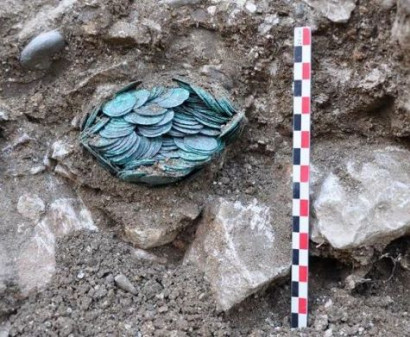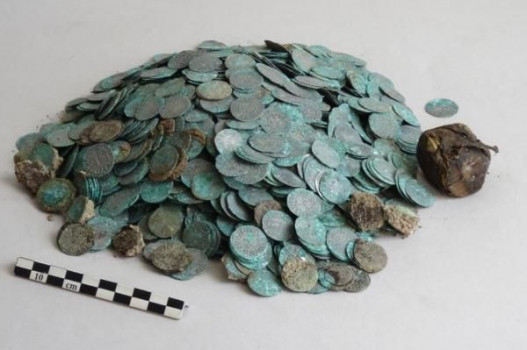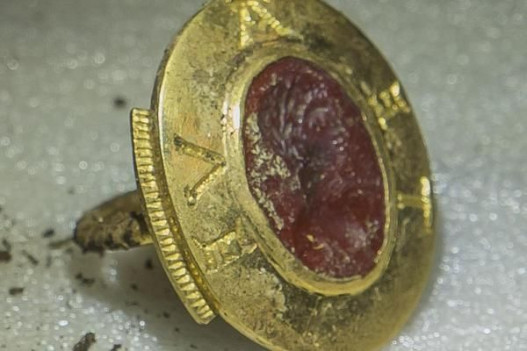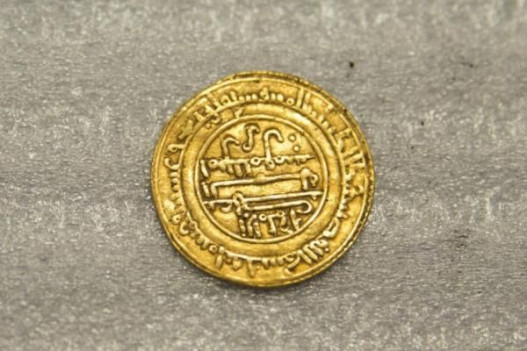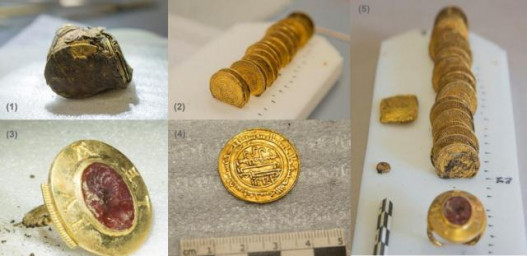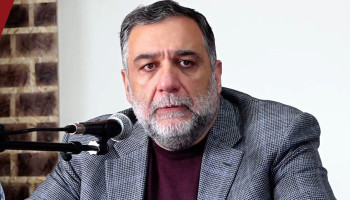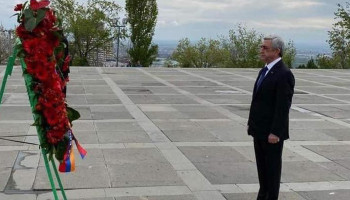In mid-September, a large treasure was unearthed during a dig at the Abbey of Cluny, in the French department of Saône-et-Loire: 2,200 silver deniers and oboles, 21 Islamic gold dinars, a signet ring,1 and other objects made of gold. Never before has such a large cache of silver deniers been discovered. Nor have gold coins from Arab lands, silver deniers, and a signet ring ever been found hoarded together within a single, enclosed complex.
Anne Baud, an academic at the Université Lumière Lyon 2, and Anne Flammin, a CNRS engineer—both from the Laboratoire Archéologie et Archéométrie (CNRS / Université Lumière Lyon 2 / Claude Bernard Lyon 1 University)—led the archaeological investigation, in collaboration with a team of 9 students from the Université Lumière Lyon 2 and researchers from the Maison de l'Orient et de la Méditerranée Jean Pouilloux (CNRS / Université Lumière Lyon 2).The excavation campaign, authorized by the Bourgogne–Franche-Comté Regional Department of Cultural Affairs (DRAC), began in mid-September and ended in late October. It is part of a vast research program focused on the Abbey of Cluny. Students in the Master of Archaeology and Archaeological Science program at the Université Lumière Lyon 2 have been participating in archaeological digs at the Abbey of Cluny since 2015. This experience in the field complements their academic training and gives them an insight into professional archaeology.
At the site, the team led by Anne Baud et Anne Flammin, including the students from the Université Lumière Lyon 2, discovered a treasure consisting of
- more than 2,200 silver deniers and oboles—mostly minted by the Abbey of Cluny and probably dating to the first half of the 12th century—in a cloth bag, traces of which remain on some of the coins
- a tanned hide bundle, found among the silver coins, fastened with a knot, and enclosing
21 Islamic gold dinars struck between 1121 and 1131 in Spain and Morocco, under the reign of Ali ibn Yusuf (1106–1143), who belonged to the Berber Almoravid dynasty.
a gold signet ring with a red intaglio depicting the bust of a god and an inscription possibly dating the ring back to the first half of the 12th century
a folded sheet of gold foil weighing 24 g and stored in a case
a small circular object made of gold
Vincent Borrel, a PhD student at the Archaeology and Philology of East and West (CNRS / ENS) research unit—AOROC for short—is currently studying the treasure in more detail to identify and date the various pieces with greater precision.
A precious find . . .
This is an exceptional find for a monastic setting and especially that of Cluny, which was one of the largest abbeys of Western Europe during the Middle Ages. The treasure was buried in fill where it seems to have stayed for 850 years.
It includes items of remarkable value: 21 gold dinars and a signet ring, a very expensive piece of jewelry that few could own during the Middle Ages. At that time, Western currency was mostly dominated by the silver denier. Gold coins were reserved for rare transactions. The 2,200 or so silver deniers, struck at Cluny or nearby, would have been for everyday purchases. This is the largest stash of such coins ever found.
The fact that Arab currency, silver deniers, and a signet ring were enclosed together makes this discovery all the more interesting.
. . . opening new avenues of research into the history of the Abbey of Cluny
This discovery will breathe new life into research delving into the past of the abbey, a historic site open to the public and managed by the Centre des Monuments Nationaux (CMN). It also raises new questions worth answering:
- Who owned the treasure? Was it a monk, a church dignitary, or a rich layman?
- What can the coins teach us? Where were the silver deniers of Cluny struck? Where did they circulate? How did Islamic dinars minted in Spain and Morocco end up at Cluny?
- Why was the treasure buried?
- What building lay above the treasure when it was hidden? Was it a building, now in ruins, that we know little about?About the Laboratoire Archéologie et Archéométrie (CNRS / Université Lumière Lyon 2 / Claude Bernard Lyon 1 University):
The Laboratoire Archéologie et Archéométrie (CNRS / Université Lumière Lyon 2 / Claude Bernard Lyon 1 University) is part of the Maison de l'Orient et de la Méditerranée Jean Pouilloux (CNRS / Université Lumière Lyon 2), or MOM, a federation of research units focused on the study of past civilizations. It brings together archaeologists, archaeometrists, specialists in the study of ceramic artifacts, and technical and administrative staff from the CNRS and the Université Lumière Lyon 2, all working together to shed light on French and Near Eastern societies of antiquity and the Middle Ages.
MOM is the home of the Centre de Datation par le Radiocarbone, located on the campus of Claude Bernard Lyon 1 University.
About the Université Lumière Lyon 2:
Created in 1973, the Université Lumière Lyon 2 is a French leader for studies in humanities and social sciences. It fosters innovative, ethical, and socially engaged research. The university's 31 research units address a wide spectrum of themes that span twenty-some disciplines, touching on all areas of the arts, language, literature, social science, law, economics, management, and psychology. These units rely on diverse methods and resources, including documentation, digitalization, AV media, information systems, and experimental platforms.
Most of them are active on more than one site, led by two or more different bodies, and associated with various research federations as well as the Institut des Sciences de l'Homme. Their total research staff includes more than 600 academics and 1,200 PhD students from 7 different doctoral schools.
About the CNRS:
The French National Center for Scientific Research, or CNRS, is the leading public research body in France and indeed in Europe. The CNRS produces knowledge that it applies for the benefit of society. With more than 32,000 employees, a budget of €3.2 billion in 2016 (including €749 million of self-generated income), more than 1,100 research units, and a network of sites across France, the CNRS is active in all fields of knowledge. It carries on a tradition of excellence, boasting 21 Nobel prizewinners and 12 Fields medalists. CNRS staff conducts research in all areas of scientific, technological, and societal interest: mathematics; physics (including nuclear and particle physics); IT and communication sciences; Earth sciences; astronomy; chemistry; life sciences; social sciences and the humanities; environmental sciences; and engineering.
About the Claude Bernard Lyon 1 University:
For more than 40 years, Claude Bernard Lyon 1 University has offered excellent academic programs in science, technology, health, and sports while hosting cutting-edge research activities. Its current student population numbers 45,000. The university's 5,000 staff members are committed to providing a top-notch education that reflects real needs in the field, and to conducting high-quality research, so that all students may confidently lay the foundations for their professional careers. The university has two priorities: professional integration (90% of its graduates find employment) and research (conducted by 2,700 academics grouped into 67 units, with access to specialized infrastructure). Credited with more patent registrations than any other French university, Claude Bernard Lyon 1 University combines basic and applied research to address tomorrow's main challenges.
About the Bourgogne–Franche-Comté Regional Department of Cultural Affairs (DRAC):
The Bourgogne–Franche-Comté DRAC is a decentralized division of the French Ministry of Culture that reports to the regional prefect. It helps disseminate public policy in the region, ensuring implementation of regulations, providing guidance in its areas of expertise, and evaluating cultural policies.
The DRAC is involved in
studying, protecting, preserving, and capitalizing on the cultural legacy of archaeological sites, historic monuments, museums, archives, and written works
showcasing architecture
supporting all aspects of artistic endeavor and transmission
championing books and reading
educating the public about art, culture, and the transmission of knowledge
fostering cultural diversity and broadening audiences
developing the cultural economy and cultural industries
promoting French and the languages of France
A further, important role of the DRAC is to provide guidance and assessment services to local authorities, institutions, and cultural associations. It is thus a key point of contact for elected officials, artists, professionals, associations, and all citizens who seek to advance cultural creation.
About the Centre des Monuments Nationaux (CMN):
The archaeological sites of Glanum and Carnac, the Abbeys of Montmajour and Mont-Saint-Michel, Château d'If and Azay-le-Rideau, Saint-Cloud National Domain, Arc de Triomphe, Villa Savoye, and Villa Cavrois are just a few of the hundred state-owned national monuments managed by the CMN.
It is the main public operator of cultural sites of interest to tourists, working to preserve these exceptional landmarks, parks, and gardens, which attract more than 9.2 million tourists every year. The diversity of these sites bears witness to the wealth of French cultural heritage.
The CMN makes use of a multitiered fee schedule to make these treasures accessible to all members of the public. Ticket and shop sales, facility rentals, and donations cover 84% of its operating expenses. The CMN pools and distributes its resources where most needed, enhancing the value of its network of cultural sites as a whole. Profits made at some sites are used to fund cultural and scientific initiatives for all.
The CMN recently opened the Fort de Brégançon (2014) and the restored Villa Cavrois (2015) to the public. It now also manages Villa Kérylos, which belongs to the Institut de France. And it is preparing for 2018 visitor access to the Colonne de Juillet and the Hôtel de la Marine in Paris.
